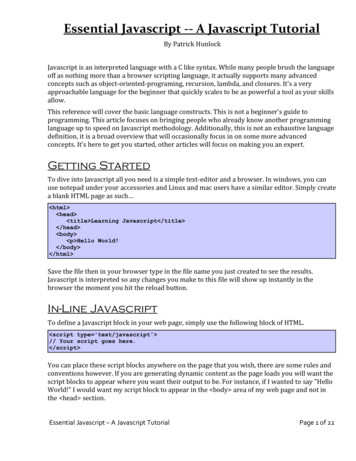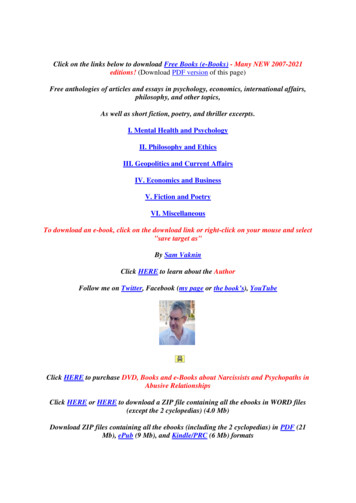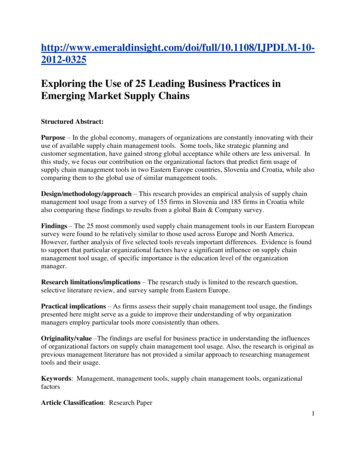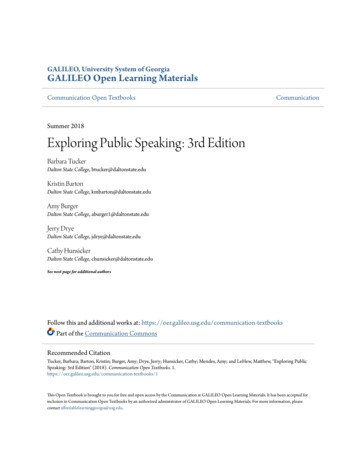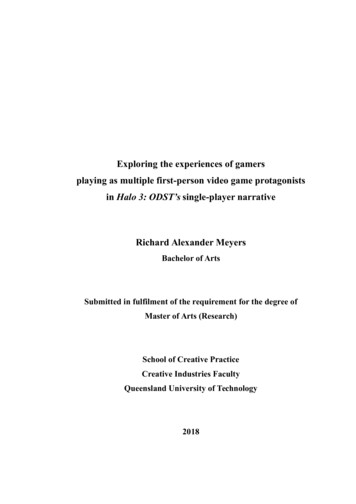
Transcription
Deep JavaScriptTheory and techniquesDr. Axel Rauschmayer
2
Deep JavaScriptDr. Axel Rauschmayer2020
Copyright 2020 by Dr. Axel RauschmayerCover photo by Jakob Boman on UnsplashAll rights reserved. This book or any portion thereof may not be reproduced or used inany manner whatsoever without the express written permission of the publisher exceptfor the use of brief quotations in a book review or scholarly journal.exploringjs.com
ContentsIFrontmatter1About this book1.1 Where is the homepage of this book?1.2 What is in this book? . . . . . . . . .1.3 What do I get for my money? . . . .1.4 How can I preview the content? . . .1.5 How do I report errors? . . . . . . . .1.6 Tips for reading . . . . . . . . . . . .1.7 Notations and conventions . . . . . .1.8 Acknowledgements . . . . . . . . . .II5.Types, values, variables777888889112Type coercion in JavaScript2.1 What is type coercion? . . . . . . . . . . . . . . . . . . . . . . . . . . . .2.2 Operations that help implement coercion in the ECMAScript specification2.3 Intermission: expressing specification algorithms in JavaScript . . . . . .2.4 Example coercion algorithms . . . . . . . . . . . . . . . . . . . . . . . . .2.5 Operations that coerce . . . . . . . . . . . . . . . . . . . . . . . . . . . .2.6 Glossary: terms related to type conversion . . . . . . . . . . . . . . . . .131316181927303The destructuring algorithm3.1 Preparing for the pattern matching algorithm3.2 The pattern matching algorithm . . . . . . . .3.3 Empty object patterns and Array patterns . . .3.4 Applying the algorithm . . . . . . . . . . . .45.3131333536Environments: under the hood of variables4.1 Environment: data structure for managing variables4.2 Recursion via environments . . . . . . . . . . . . .4.3 Nested scopes via environments . . . . . . . . . . .4.4 Closures and environments . . . . . . . . . . . . .3939394044A detailed look at global variables5.1 Scopes . . . . . . . . . . . . . . . . . . . . . . . . . . . . . . . . . . . . .5.2 Lexical environments . . . . . . . . . . . . . . . . . . . . . . . . . . . . .4747483.
4CONTENTS5.35.45.55.65.7III678IV9The global object . . . . . . . . . . . . . . . . . . . . . . . . . . . . . . .In browsers, globalThis does not point directly to the global object . . .The global environment . . . . . . . . . . . . . . . . . . . . . . . . . . .Conclusion: Why does JavaScript have both normal global variables andthe global object? . . . . . . . . . . . . . . . . . . . . . . . . . . . . . . .Further reading and sources of this chapter . . . . . . . . . . . . . . . . .Working with dataCopying objects and Arrays6.1 Shallow copying vs. deep copying6.2 Shallow copying in JavaScript . .6.3 Deep copying in JavaScript . . . .6.4 Further reading . . . . . . . . . .484849515355.5757586265Updating data destructively and non-destructively7.1 Examples: updating an object destructively and non-destructively7.2 Examples: updating an Array destructively and non-destructively7.3 Manual deep updating . . . . . . . . . . . . . . . . . . . . . . . .7.4 Implementing generic deep updating . . . . . . . . . . . . . . . .6767686969The problems of shared mutable state and how to avoid them8.1 What is shared mutable state and why is it problematic? . .8.2 Avoiding sharing by copying data . . . . . . . . . . . . . .8.3 Avoiding mutations by updating non-destructively . . . .8.4 Preventing mutations by making data immutable . . . . .8.5 Libraries for avoiding shared mutable state . . . . . . . . .717173757676.OOP: object property attributesProperty attributes: an introduction9.1 The structure of objects . . . . . . . . . . . . . . . . .9.2 Property descriptors . . . . . . . . . . . . . . . . . .9.3 Retrieving descriptors for properties . . . . . . . . .9.4 Defining properties via descriptors . . . . . . . . . .9.5 Object.create(): Creating objects via descriptors . .9.6 Use cases for Object.getOwnPropertyDescriptors()9.7 Omitting descriptor properties . . . . . . . . . . . . .9.8 What property attributes do built-in constructs use? .9.9 API: property descriptors . . . . . . . . . . . . . . . .9.10 Further reading . . . . . . . . . . . . . . . . . . . . .10 Where are the remaining chapters?79.818284858688899192959799
Part IFrontmatter5
Chapter 1About this bookContents1.1Where is the homepage of this book?. . . . . . . . . . . . . . . . .71.2What is in this book? . . . . . . . . . . . . . . . . . . . . . . . . . . .71.3What do I get for my money? . . . . . . . . . . . . . . . . . . . . . .81.4How can I preview the content? . . . . . . . . . . . . . . . . . . . . .81.5How do I report errors? . . . . . . . . . . . . . . . . . . . . . . . . .81.6Tips for reading. . . . . . . . . . . . . . . . . . . . . . . . . . . . .81.7Notations and conventions . . . . . . . . . . . . . . . . . . . . . . .81.7.1What is a type signature? Why am I seeing static types in thisbook? . . . . . . . . . . . . . . . . . . . . . . . . . . . . . . .8What do the notes with icons mean? . . . . . . . . . . . . . . .9Acknowledgements . . . . . . . . . . . . . . . . . . . . . . . . . . .91.7.21.81.1Where is the homepage of this book?The homepage of “Deep JavaScript” is exploringjs.com/deep-js/1.2What is in this book?This book dives deeply into JavaScript: It teaches practical techniques for using the language better. It teaches how the language works and why. What it teaches is firmly groundedin the ECMAScript specification (which the book explains and refers to). It covers only the language (ignoring platform-specific features such as browserAPIs) but not exhaustively. Instead, it focuses on a selection of important topics.7
81 About this book1.3What do I get for my money?If you buy this book, you get: The current content in four DRM-free versions:– PDF file– ZIP archive with ad-free HTML– EPUB file– MOBI file Any future content that is added to this edition. How much I can add depends onthe sales of this book.The current price is introductory. It will increase as more content is added.1.4How can I preview the content?On the homepage of this book, there are extensive previews for all versions of this book.1.5How do I report errors? The HTML version of this book has a link to comments at the end of each chapter. They jump to GitHub issues, which you can also access directly.1.6Tips for reading You can read the chapters in any order. Each one is self-contained but occasionally,there are references to other chapters with further information. The headings of some sections are marked with “(optional)” meaning that theyare non-essential. You will still understand the remainders of their chapters if youskip them.1.71.7.1Notations and conventionsWhat is a type signature? Why am I seeing static types in thisbook?For example, you may see:Number.isFinite(num: number): booleanThat is called the type signature of Number.isFinite(). This notation, especially the statictypes number of num and boolean of the result, are not real JavaScript. The notationis borrowed from the compile-to-JavaScript language TypeScript (which is mostly justJavaScript plus static typing).Why is this notation being used? It helps give you a quick idea of how a function works.The notation is explained in detail in a 2ality blog post, but is usually relatively intuitive.
1.8 Acknowledgements1.7.29What do the notes with icons mean?Reading instructionsExplains how to best read the content.External contentPoints to additional, external, content.TipGives a tip related to the current content.QuestionAsks and answers a question pertinent to the current content (think FAQ).WarningWarns about pitfalls, etc.DetailsProvides additional details, complementing the current content. It is similar to afootnote.1.8Acknowledgements Thanks to Allen Wirfs-Brock for his advice via Twitter and blog post comments. Ithelped make this book better. More people who contributed are acknowledged in the chapters.
101 About this book
Part IITypes, values, variables11
Chapter 2Type coercion in JavaScriptContents2.1What is type coercion? . . . . . . . . . . . . . . . . . . . . . . . . . .132.1.1Dealing with type coercion . . . . . . . . . . . . . . . . . . . .15Operations that help implement coercion in the ECMAScript specification . . . . . . . . . . . . . . . . . . . . . . . . . . . . . . . . . .162.2.1Converting to primitive types and objects . . . . . . . . . . . .162.2.2Converting to numeric types . . . . . . . . . . . . . . . . . . .162.2.3Converting to property keys . . . . . . . . . . . . . . . . . . .172.2.4Converting to Array indices . . . . . . . . . . . . . . . . . . .172.2.5Converting to Typed Array elements . . . . . . . . . . . . . .182.3Intermission: expressing specification algorithms in JavaScript . . .182.4Example coercion algorithms . . . . . . . . . . . . . . . . . . . . . .192.4.1ToPrimitive() . . . . . . . . . . . . . . . . . . . . . . . . . .192.4.2ToString() and related operations. . . . . . . . . . . . . . .222.4.3ToPropertyKey() . . . . . . . . . . . . . . . . . . . . . . . . .262.4.4ToNumeric() and related operations . . . . . . . . . . . . . . .26Operations that coerce . . . . . . . . . . . . . . . . . . . . . . . . . .272.5.1Addition operator ( ) . . . . . . . . . . . . . . . . . . . . . . .272.5.2Abstract Equality Comparison ( ) . . . . . . . . . . . . . . .282.22.52.6Glossary: terms related to type conversion. . . . . . . . . . . . . .30In this chapter, we examine the role of type coercion in JavaScript. We will go relativelydeeply into this subject and, e.g., look into how the ECMAScript specification handlescoercion.2.1What is type coercion?Each operation (function, operator, etc.) expects its parameters to have certain types. Ifa value doesn’t have the right type for a parameter, three common options for, e.g., afunction are:13
142 Type coercion in JavaScript1. The function can throw an exception:function multiply(x, y) {if (typeof x ! 'number' typeof y ! 'number') {throw new TypeError();}// ···}2. The function can return an error value:function multiply(x, y) {if (typeof x ! 'number' typeof y ! 'number') {return NaN;}// ···}3. The function can convert its arguments to useful values:function multiply(x, y) {if (typeof x ! 'number') {x Number(x);}if (typeof y ! 'number') {y Number(y);}// ···}In (3), the operation performs an implicit type conversion. That is called type coercion.JavaScript initially didn’t have exceptions, which is why it uses coercion and error valuesfor most of its operations:// Coercionassert.equal(3 * true, 3);// Error valuesassert.equal(1 / 0, Infinity);assert.equal(Number('xyz'), NaN);However, there are also cases (especially when it comes to newer features) where itthrows exceptions if an argument doesn’t have the right type: Accessing properties of null or undefined: undefined.propTypeError: Cannot read property 'prop' of undefined null.propTypeError: Cannot read property 'prop' of null 'prop' in nullTypeError: Cannot use 'in' operator to search for 'prop' in null
152.1 What is type coercion? Using symbols: 6 / Symbol()TypeError: Cannot convert a Symbol value to a number Mixing bigints and numbers: 6 / 3nTypeError: Cannot mix BigInt and other types New-calling or function-calling values that don’t support that operation: 123()TypeError: 123 is not a function (class {})()TypeError: Class constructorcannot be invoked without 'new' new 123TypeError: 123 is not a constructor new (() {})TypeError: (intermediate value) is not a constructor Changing read-only properties (only throws in strict mode): 'abc'.length 1TypeError: Cannot assign to read only property 'length' Object.freeze({prop:3}).prop 1TypeError: Cannot assign to read only property 'prop'2.1.1Dealing with type coercionTwo common ways of dealing with coercion are: A caller can explicitly convert values so that they have the right types. For example,in the following interaction, we want to multiply two numbers encoded as strings:let x '3';let y '2';assert.equal(Number(x) * Number(y), 6); A caller can let the operation make the conversion for them:let x '3';let y '2';assert.equal(x * y, 6);I usually prefer the former, because it clarifies my intention: I expect x and y not to benumbers, but want to multiply two numbers.
162 Type coercion in JavaScript2.2Operations that help implement coercion in theECMAScript specificationThe following sections describe the most important internal functions used by the ECMAScript specification to convert actual parameters to expected types.For example, in TypeScript, we would write:function isNaN(number: number) {// ···}In the specification, this looks as follows (translated to JavaScript, so that it is easier tounderstand):function isNaN(number) {let num ToNumber(number);// ···}2.2.1Converting to primitive types and objectsWhenever primitive types or objects are expected, the following conversion functionsare used: )These internal functions have analogs in JavaScript that are very similar: Boolean(0)false Boolean(1)true Number('123')123After the introduction of bigints, which exists alongside numbers, the specification oftenuses ToNumeric() where it previously used ToNumber(). Read on for more information.2.2.2Converting to numeric typesAt the moment, JavaScript has two built-in numeric types: number and bigint. ToNumeric() returns a numeric value num. Its callers usually invoke
types numberof numand booleanof the result, are not real JavaScript. The notation The notation Script(whichismostlyjust
